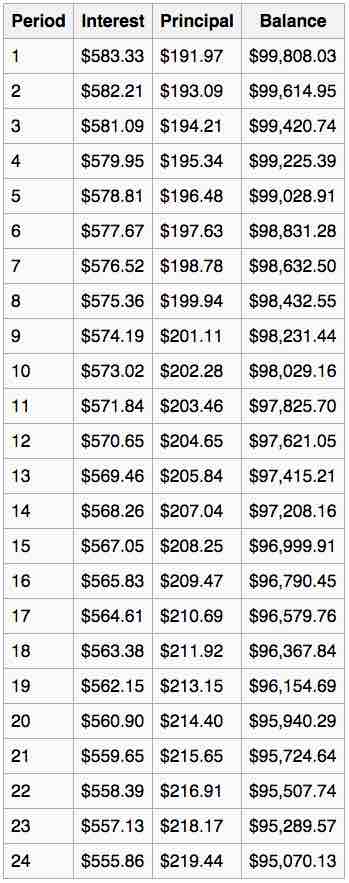When a bond is issued at a premium, that means that the bond is sold for an amount greater than the bond's face value. This generally means that the bond's contract rate is greater than the market rate. Like with a bond that is sold at a discount, the difference between the bond's face value and sales price must be amortized over the term of the bond. However, unlike with a bond sold at a discount, the process of amortizing the premium will decrease the bond's interest expense recorded on the issuing company's financial records. The issuing company will still be required to pay the bondholder the interest payments guaranteed by the bond.

Amortization Schedule
An example of an amortization schedule of a $100,000 loan over the first two years.
Bond Issue
When the bond is issued, the company must debit the cash account by the amount that the business receives for the bond sale. A liability, titled "bond payable," must be created and credited by an amount equal to the face value of the issued bonds. The difference between the cash from the bond sale and the face value of the bond must be credited to a bond premium account.
For example, assume a business issues a 10-year bond that pays 6% interest annually, with a face value of $100,000. This bond sells for $110,000. The resulting journal entry would be:
Cash - $110,000
Bond Payable - $100,000
Bond Premium - $100,000
Interest Payments on the Bond
When the business pays interest, it must also amortize the bond premium at that time. To calculate the amortization rate of the bond premium, a company generally divides the bond premium amount by the number of interest payments that will be made during the term of the bond. Every time interest is paid, the company must credit cash for the interest amount paid to the bond holder. The company must debit the bond premium account by the amortization rate. The difference between the amount paid in interest and the premium's amortization for the period is the interest expense for that period.
Using the example from above, the $10,000 premium would be divided by 10 annual interest payments. This would make the amortization rate of the bond's premium equal to $1,000 per year. The company must pay $6,000 in interest annually, so the company's annual interest expense equals $5,000. The resulting journal entry is:
Bond Interest Expense - $5,000
Bond Premium - $1,000
Cash - $6,000
Bond Reaches Maturity
When the bond reaches maturity, the company must pay the bondholder the face value of the bond, finish amortizing the premium, and pay any remaining interest obligations. When all the final journal entries are made, the bond premium and bond payable account must equal zero.
Using the example, this is what the final journal entries must look like:
Bond Interest Expense - $5,000
Bond Premium - $1,000
Cash - $6,000
Bond Payable - $100,000
Cash - $100,000